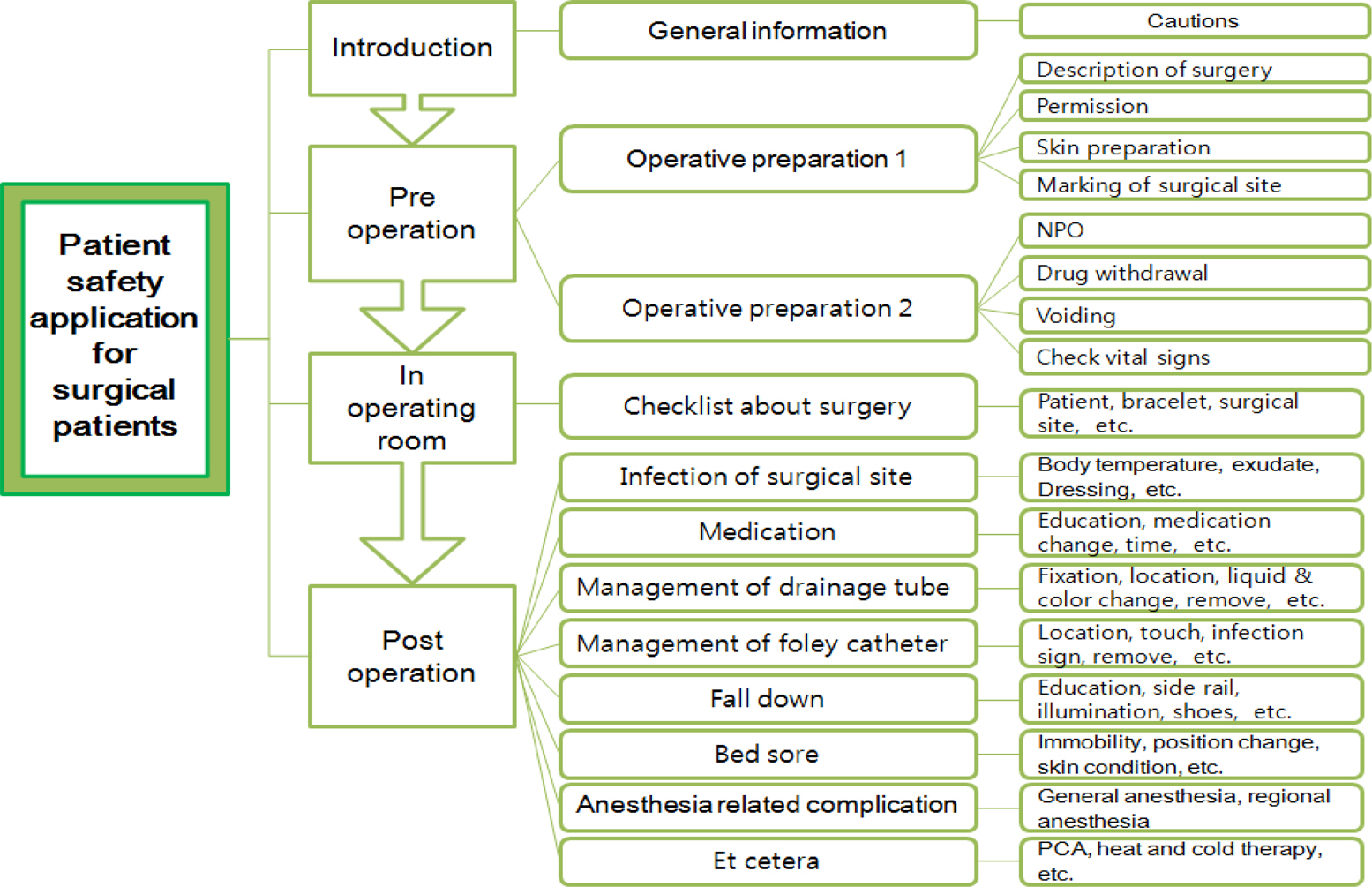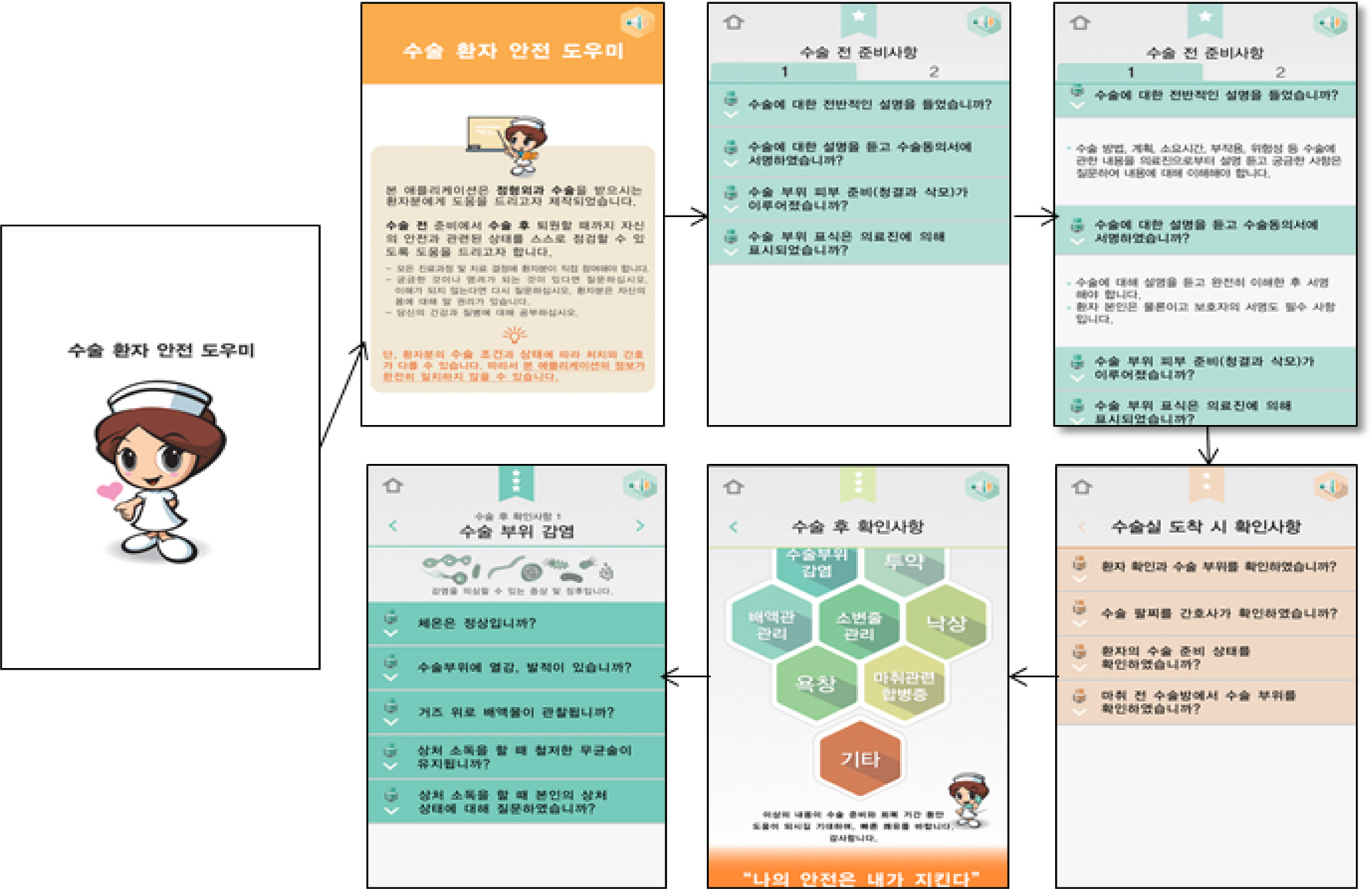Korean J Adult Nurs.
2017 Apr;29(2):154-165. 10.7475/kjan.2017.29.2.154.
The Effects of Smartphone Application to Educate Patient on Patient Safety in Hospitalized Surgical Patients
- Affiliations
-
- 1Department of Nursing, Sunlin University, Pohang, Korea.
- 2College of Nursing, Research Institute of Nursing Science, Kyungpook National University, Daegu, Korea. jewelee@knu.ac.kr
- KMID: 2378869
- DOI: http://doi.org/10.7475/kjan.2017.29.2.154
Abstract
- PURPOSE
This study was designed to evaluate a patient safety application in the prevention of adverse event among surgical patients. Seventy three surgical patients with thirty six of them using the patient safety application and the rest (N=37) were provided educational booklet. Further, the instrument would measure patients' right to know, knowledge about patient safety, and attitude toward patient safety.
METHODS
The patient safety application was developed by the ADDIE along with input from experts, patients and an extensive literature review. Data were collected from 7 September through 20 October 2015.
RESULTS
The experimental group had significantly higher scores in patients' right to know (t=2.01, p=.024), knowledge on patient safety (t=3.80, p<.001) and attitude toward patient safety (t=2.74, p=.004) than those of the control group.
CONCLUSION
The patient safety application developed using Smartphone could be an effective tool enhancing patient involvement in preventing adverse events that may occur to patients. Further studies are recommended with diverse subjects with varying medical conditions.
MeSH Terms
Figure
Reference
-
1. Institute of Medicine. Patient safety: Achieving a new standard for care. Washington, DC: National Academy Press;2004. p. 1–42.2. Joint Commission Resources. Front line of defense: the role of nurses in preventing sentinel events. Kim JE, Park MH, Park SY, Lee SY. Translator. Seoul: E public;2008.3. Korea Statical Information Service. Surgical cases per 100, 000 population [Internet]. Seoul: Author;2013. [cited 2014 January 16]. Available from:. http://kosis.kr/wnsearch/totalSearch.jsp.4. Korea Medical Dispute Mediation and Arbitration Agency. Medical dispute mediation and arbitration-statistical year-book 2014 [Internet]. Seoul: Author;2015. [cited 2015 June 20]. Available from:. http://www.k-medi.or.kr.5. Kim SK, Lee H, Oh EG. Perceived level and associated factors of patient safety culture among health care providers in an operating room. Journal of Korean Clinical Nursing Research. 2010; 16(2):57–67.6. Mehtsun WT, Ibrahim AM, Diener-West M, Pronovost PJ, Makary MA. Surgical never events in the United States. Surgery. 2013; 153(4):465–72. https://doi.org/10.1016/j.surg.2012.10.005.
Article7. Weingart S, Zhu J, Chiappetta L, Stuver SO, Schneider EC, Epstein AM, et al. Hospitalized patients' participation and its impact on quality of care and patient safety. International Journal for Quality in Health Care. 2011; 23(3):269–77. https://doi.org/10.1093/intqhc/mzr002.
Article8. Groene O. Patient centeredness and quality improvement ef-forts in hospitals: rationale, measurement, implementation. International Journal for Quality in Health Care. 2011; 23(5):531–37. https://doi.org/10.1093/intqhc/mzr058.9. Kim MR. Concept analysis of patient safety. Journal of Korean Academy of Nursing. 2011; 41(1):1–8. https://doi.org/10.4040/jkan.2011.41.1.1.
Article10. Longtin Y, Sax H, Leape LL, Sheridan SE, Donaldson L, Pittent D. Patient participation: current knowledge and applicability to patient safety. Mayo Clinic Proceedings. 2010; 85(1):53–62. https://doi.org/10.4065/mcp.2009.0248.
Article11. Ahn SH, Kim YS, Yoo MS, Bang KS. A patient's right to know and self-determination. The Korean Journal of Medical Ethics. 2009; 12(2):153–64.12. Ministry of Science. 2015 Internet use survey-summary report (December 31) [Internet]. Seoul: Author;2015. [cited 2016 May 17]. Available from:. http://www.msip.go.kr/cms/www/news/news/report/.13. Pyo MY, Kim JY, Sohn JO, Lee ES, Kim HS, Kim KO, et al. The effects of an advanced cardiac life support training via smartphone's simulation application on nurses' knowledge and learning satisfaction. Journal of Korean Clinical Nursing Research. 2012; 18(2):228–38.14. Miller AS, Cafazzo JA, Seto E. A game plan: gamification design principles in mHealth applications for chronic disease management. Health Informatics Journal. 2016; 22(2):184–93. https://doi.org/10.1177/1460458214537511.
Article15. Kim MS, Park JH, Park KY. Development and effectiveness of a drug dosage calculation training program using cognitive loading theory based on smartphone application. Journal of Korean Academy of Nursing. 2012; 42(5):689–98. https://doi.org/10.4040/jkan.2012.42.5.689.
Article16. Kirwan M, Vandelanotte C, Fenning A, Duncan MJ. Diabetes self-management smartphone application for adults with type 1 diabetes: randomized controlled trial. Journal of Medical Internet Research. 2013; 15(11):e235. https://doi.org/10.2196/jmir.2588.
Article17. Jeon JH. Development and evaluation of smartphone application for self-care performance of patients with chronic hepatitis B [dissertation]. Seoul: Chung-Ang University;2015. p. 1–176.18. Molenda M. In search of the elusive ADDIE model. Performance Improvement. 2003; 42(5):34–6.
Article19. Agency for Healthcare Research and Quality. The 10 questions you should know [Internet]. Rockville: Agency for Healthcare Research and Quality;2010. [cited 2014 March 20]. Available from:. http://www.ahrq.gov/patients-consumers/patient-in-volvement/ask-your-doctor/10questions.html.20. Agency for Healthcare Research and Quality. 20 tips to help prevent medical errors [Internet]. Rockville: Agency for Healthcare Research and Quality;2011. [cited 2014 March 20]. Available from. http://www.ahrq.gov/patients-consumers/patient-involvement/ask-your-doctor/tips-and-tools/index.html.21. The Joint Commission. Speak up brochures [Internet]. Oakbrook Terrace: The Joint Commission;2002. [cited 2015 September 20]. Available from:. http://www.jointcommission.org/topics/speakup_brochures.aspx.22. World Health Organization. What you need to know before and after surgery [Internet]. Geneva: World Health Organization;2015. [cited 2015 June 7]. Available from:. http://www.who.int/patientsafety/patients??for?patient/en/.23. Kim M. Development and evaluation of health care smart phone application evaluation tool [master's thesis]. Seoul: Seoul National University;2014. p. 1–65.24. Faul F, Erdfelder E, Lang AG, Buchner A. G∗Power 3.1: a flexi-ble statistical power analysis program for the social, behavioral, and biomedical sciences. Behavior Research Methods. 2007; 39(2):175–91. https://doi.org/10.3758/BF03193146.25. Flin R, Patey R, Jackson J, Mearns K, Dissanayaka U. Year 1 medical undergraduates' knowledge of and attitudes to medical error. Medical Education. 2009; 43(12):1147–55. https://doi.org/10.1111/j.1365-2923.2009.03499.x.
Article26. Patey R, Flin R, Cuthbertson BH, MacDonald L, Mearns K, Cleland J, et al. Patient safety: helping medical students under-stand error in healthcare. Quality and Safety in Health Care. 2007; 16(4):256–9.
Article27. Park BK, Lee E. Effects of my child's safety web-based program for caregivers of children with cancer in South Korea. Healthcare Informatics Research. 2014; 30(3):199–208. https://doi.org/10.4258/hir.2014.20.3.199.
Article28. Haynes AB, Weiser TG, Berry WR, Lipsitz SR, Breizat A-HS, Dellinger E, et al. Changes in safety attitude and relationship to decreased postoperative morbidity and mortality following implementation of a checklist-based surgical safety intervention. BMJ Quality & Safety. 2011; 20(1):102–7. https://doi.org/10.1136/bmjqs.2009.040022.
Article29. Watts BV, Percarpio K, West P, Mills PD. Use of the safety attitudes questionnaire as a measure in patient safety improvement. Journal of Patient Safety. 2010; 6(4):206–9. https://doi.org/10.1097/PTS.0b013e3181fbbe86.
Article30. Kim JE, Lee NJ, Jang SM, Kim YM. Healthcare service consum-ers' perception of patient safety. Perspectives in Nursing Science. 2013; 10(2):133–40.
- Full Text Links
- Actions
-
Cited
- CITED
-
- Close
- Share
- Similar articles
-
- Effects of Self-Education on Patient Safety via Smartphone Application for Self-Efficacy and Safety Behaviors of Inpatients in Korea
- Can Patient Education with a Smartphone Application Improve the Quality of Bowel Preparation for Colonoscopy?
- The Development and Application Effects of a Fatigue Self-Care Smartphone Application for Lung Cancer Patients Receiving Chemotherapy
- Development and Effectiveness of Smartphone Application for the Medication Confirmation of High-alert Medications
- The Relationship Between Types of Smartphone Use, Digital Literacy, and Smartphone Addiction in the Elderly




